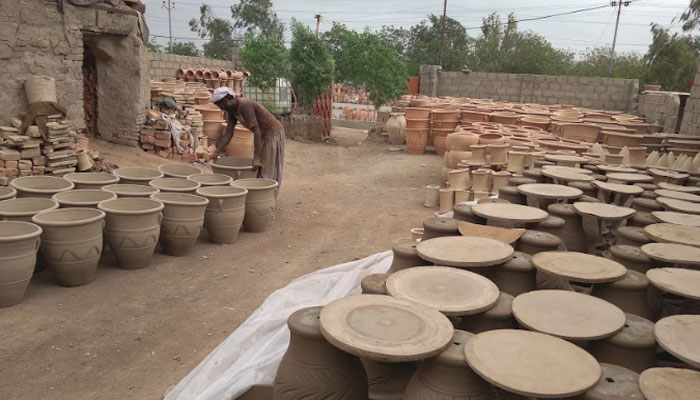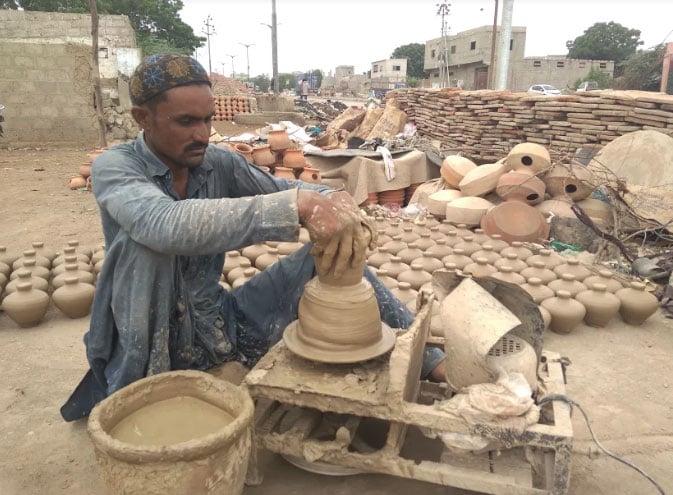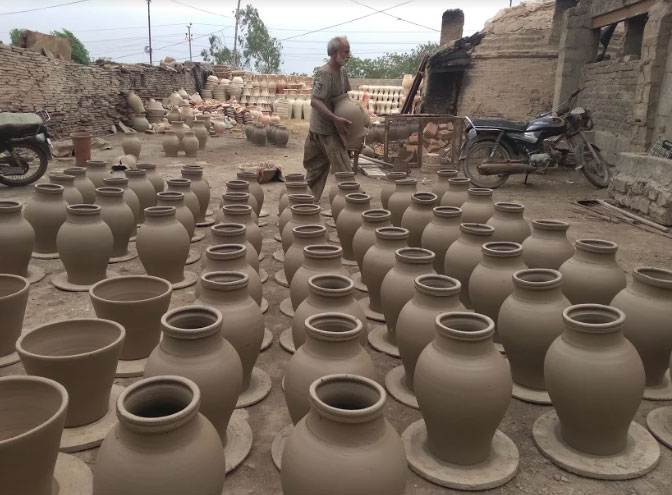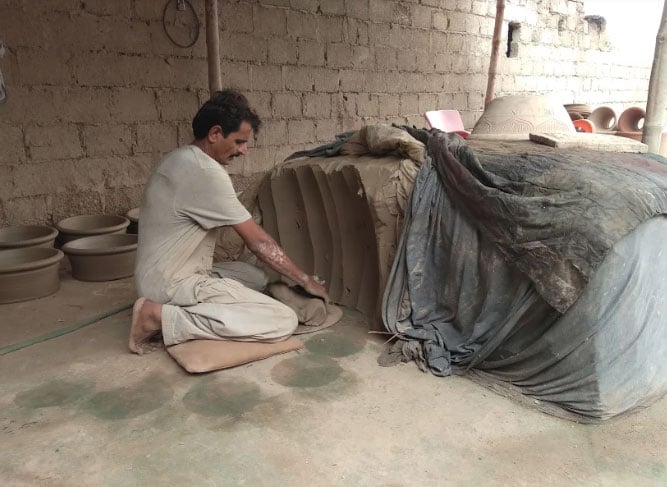Foreigners fill the gap as native potters of Karachi abandon age-old craft
Under the open sky, on a roadside in an underdeveloped locality of New Karachi, Muhammad Shafiq is immersed in making earthenware on a potter’s wheel. The workplace is devoid of any shelter or walls while mud, clay and some combustible materials are spread on the ground all over.
The potter does not mind doing his work at a place without any roof and walls as such an environment is the requirement of his profession. A number of earthenware coin-containers, called Gullaks in Urdu, have been arranged on the ground behind him so that they could dry off in the sun.
“Our work needs an open space for drying pots off and to prepare clay from the soil,” he says, adding that “the dumped burnable material is not useless for us. We use it in baking the clay pots in the furnace”.
Shafiq raises a lump of clay on the potter’s wheel and starts giving it a shape of Gullak. His dexterity at his work suggests that he has been practising the art of pottery making since he was very young. “We have inherited this art,” he says and adds he does not even know for how many generations his ancestors have been associated with the craft of pottery.
A craft on the decline
Shafiq belongs to the Kutchi Kumhar community, which has been living in Karachi much before the independence such that it can be counted among the city’s indigenous population. Unlike many youths of his community, he is proud of his skill in pottery making and believes that there is nothing to be ashamed of in his ancestral profession.
As Kumhar means potter in Urdu, the name, Kutchi Kumhar, speaks of the fact that its people have been involved in the craft of pottery making for ages. However, many among the younger generation of the community have now abandoned the profession for various reasons.
“Our youth, particularly those who have acquired higher education, do not want to continue with their ancestral work. Some even are ashamed of their background who deny the fact that they belong to the families of Kumhars,” Shafiq says.
He laments that he would not be unable to pass the traditional craft of his ancestors over to the next generation. “Almost all the local potter families of Karachi have shifted their focus to other trades and employments. The youth do not want to learn their ancestral profession.”
Potter community in Karachi
The potter families of Karachi – notwithstanding the fact that many of them have left pottery – mostly belong to the Kutchi community. They are living in five settlements in the city, including Ratan Talao in Saddar, Juna Kumhar Wara, also known as Old Kumhar Wara, in Lyari, New Kumhar Wara in Lyari, Baldia Kumhar Wara and New Karachi Kumhar Wara.
“Kutchis are one of the oldest communities of Karachi,” says Akhtar Balouch, author of the book Karanchiwala. He further comments that the Kutchi community came to Sindh from Kutch, a district of Gujarat state in western India.
The community includes various sub-groups, including Kutchi Kumhar, Kutchi Lohar, Kutchi Sanghar, Kutchi Somra, Kutchi Junija, Kutchi Pinara, Kutchi Syed Saddat, Kutchi Mallah, Kutchi Memon and others. These groups migrated to Sindh in the late 17th century and some of them settled in Karachi afterwards, Balouch says.
According to the author, the Kutchi community had been living in Karachi before the partition. He says the community has played a role in the development of Karachi.
He calls the Kumhar faction of the Kutchis one of their underprivileged groups. “But the potter families are welcoming in nature and have been living simple lives in the city for decades,” he says.
In high demand
Contrary to the general impression of low financial returns in the ceramics business, there are some who claim that the demand for earthenware objects is currently higher than the supply, due to which pottery making is still a profitable trade.
Muhammad Nasir, who runs a workshop in New Karachi, says that as many potter families have abandoned the profession, there are not many artisans involved in pottery making these days, due to which the demand for ceramics, especially earthenware vases, is higher than their supply.
“Sometimes we can’t meet the demands of the merchants as natural process is also required in making pots,” Nasir says, referring to the requirement of dry weather in pottery making.
He adds that although clay utensils are no longer in common use and their buyers are few, the demand for earthenware vases for growing indoor plants is still very high. He also points out that some of the restaurant owners have started to serve food to their customers in clay pots, which has also boosted the business of traditional pottery.
“The clay pottery has a big market, both locally and internationally. If artisans work a little hard, they can make hefty amounts. However, youths of the potter families think that if they get involved in crafting, they will get very poor financial returns.”
Nasir also rejects the impression that the use of stainless steel and aluminium products in cooking has caused a decline in the demand for pottery.
“Such excuses have no justification. Actually, the educated ones don’t want to get their hands dirty working with mud and clay,” he says as he reiterates that there is a big demand for earthenware in the market. “Once in a week, students and artists from well-off families visit our workplaces. They ask about our work and take interest in learning the clay art.”
An inconvenient trade
Meanwhile, there are some who believe that the younger generations of potters have sound reasons for abandoning their ancestral craft and seeking out alternative sources of income as the current situation does not offer much assistance to the youth in carrying on with pottery making.
“We can’t enforce on our children what they should do and what not. There are many reasons that have affected the traditional pottery,” says 57-year-old Dawood.
He explains that one of the most significant problems for the potters is the lack of free space in the city. “Our work needs an open space where we could prepare clay, dry pots and bake them in furnaces.”
He identifies other problems in the trade, one of which is the availability of clay. For pottery, the earth to be used needs to be free from sand particles, which is not available in the city.
Transporting clay from faraway areas is very expensive, he says. “Thus, continuing the profession of pottery inside the city isn’t a good option especially when it offers low economic returns. This is why the potter families entered other businesses,” Dawood says.
Last destinations
With the increasing population of the city, the local potter families had to eventually move their workshops out of their settlements as they required furnaces and open spaces where they could easily transport clay.
Due to this very reason, the pottery workshops in the Saddar and Lyari areas started to gradually vanish and the potters found new settlements in suburbs of the city such as New Karachi and Baldia Town.
“These settlements would be their last destinations in Karachi,” Dawood says. He also points out that sticking to their ancestral profession did not improve the quality of life of the potters. “They were potters and they are. Migration from one place to another didn’t bring any change in the lives of Karachi’s potters.”
In a few years from now, there will be no potter here in the Lyari Kumar Wara, Dawood predicts. “We are witnessing that no family is carrying on with the legacy of pottery in Junah Kumhar Wara and Ratan Talao,” he says, adding that earlier, there were hundreds of families involved in pottery making in those areas.
At present, only five percent of indigenous potter families of the city are associated with the occupation of pottery. Many of them have stopped crafting earthenware and only sell ceramics at shops.
Filling the gap
Though pottery making is no longer seen in the old settlements of potters in the city, the Kumhar Wara in New Karachi, which is the largest neighbourhood of potters in Karachi, offers the sight of some potters busy in their craft – many of whom do not belong to the local potter families of the city.
As the local potters abandoned the profession of pottery making, the city simultaneously witnessed an influx of potters from various regions of the country.
The new potters of the city include Saraikis, Pashtuns, Sindhis, Kutchis and Punjabis who have set up their own workshops. “We prepare goods [clay pots] for exporters as well as provide our products to the local market,” says 30-year-old Abdul Rehman, a Pashto-speaking man who is happy with his profession.
“I had received an order from an exporter to prepare 10,000 pieces of earthen vases this season but I’m worried because I cannot deliver such a huge order within a few weeks,” he says.
Similarly, many Saraiki-speaking potters, hailing from southern Punjab, have also established many outlets to exhibit their art. “In some cases, demand could be on the decline, but our art speaks for itself and we remain busy all over the year except for the rainy seasons,” remarks Muhammad Ghulam, a Saraiki potter.
Commenting on their competition with the local potters of Karachi, Ghulam says that potters of different ethnic backgrounds have their own style of crafting and are experts in producing certain items. He adds that the local potters of Karachi, particularly the Sindhi-speaking ones and Kutchi Kumhars, were experts in manufacturing clay statues, however, they gradually had to abandon their area of expertise due to religious sensibilities of the city’s population.
According to Ghulam, the new potters in the city have introduced innovation in designs of products and brought new earthenware items to markets. He claims that nowadays the products of new potters are in demand while those of local potters hold little appeal due to which they are compelled to leave their age-old family profession.
-
 Charlie Puth Admits He Was 'very Cringe' During Early Fame
Charlie Puth Admits He Was 'very Cringe' During Early Fame -
 Prince William’s ‘failed’ Mother Diana Sparks Another Row With Prince Harry: ‘It’s Crossing A Line’
Prince William’s ‘failed’ Mother Diana Sparks Another Row With Prince Harry: ‘It’s Crossing A Line’ -
 Jennifer Garner Reflects On Special Bond With Mark Ruffalo
Jennifer Garner Reflects On Special Bond With Mark Ruffalo -
 King Charles Stuck With Supporting Prince Harry 'great Cause'
King Charles Stuck With Supporting Prince Harry 'great Cause' -
 Nicola Peltz Is 'the Issue' In Beckham Drama, Ex Stylist Claims
Nicola Peltz Is 'the Issue' In Beckham Drama, Ex Stylist Claims -
 Expert Speaks Out On Andrew’s Vicious Circle With Jeffrey Epstein Of Information Trading & Honey Traps
Expert Speaks Out On Andrew’s Vicious Circle With Jeffrey Epstein Of Information Trading & Honey Traps -
 Prince William, Kate Middleton Honour Scottish Culture By Weaving Tartan
Prince William, Kate Middleton Honour Scottish Culture By Weaving Tartan -
 King Charles’ Pact With Andrew Comes Out And It Ensures Beatrice & Eugenie Each One Thing
King Charles’ Pact With Andrew Comes Out And It Ensures Beatrice & Eugenie Each One Thing -
 ASAP Rocky Recalls 'embarrassing' First Meeting With Rihanna
ASAP Rocky Recalls 'embarrassing' First Meeting With Rihanna -
 Archie, Lilibet’s Chances At Meeting King Charles Get Promising Update: Here’s Why
Archie, Lilibet’s Chances At Meeting King Charles Get Promising Update: Here’s Why -
 Claire Foy Shares Rare Views On Typecasting Amid New Gig
Claire Foy Shares Rare Views On Typecasting Amid New Gig -
 Britney Spears Raves About Madonna In New Social Media Post
Britney Spears Raves About Madonna In New Social Media Post -
 Hailey Bieber Shares Sweet Snap Of Husband And Baby
Hailey Bieber Shares Sweet Snap Of Husband And Baby -
 Therapist Killed In Office As Former Client Launches Knife Attack
Therapist Killed In Office As Former Client Launches Knife Attack -
 Gaten Matarazzo Brands 'Stranger Things' Final Scene 'nerve-racking'
Gaten Matarazzo Brands 'Stranger Things' Final Scene 'nerve-racking' -
 David Beckham Speaks Out After Son Brooklyn Beckham's Shocking Post
David Beckham Speaks Out After Son Brooklyn Beckham's Shocking Post







